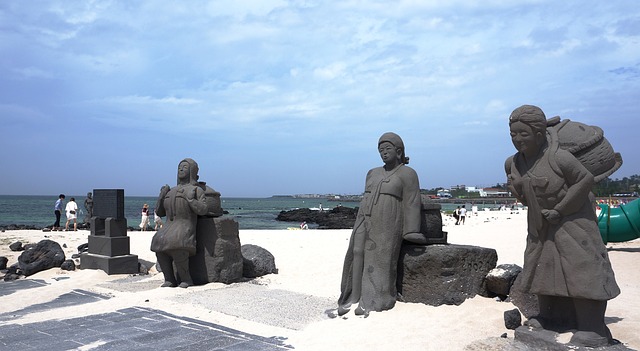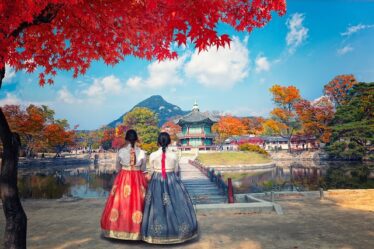
Jeju Island, located off the southern coast of South Korea, is a captivating destination known for its stunning natural landscapes, unique geological formations, and rich cultural heritage. Often referred to as the “Hawaii of South Korea,” Jeju Island offers a diverse range of experiences, from volcanic landscapes and lush forests to pristine beaches and vibrant local traditions. This comprehensive guide explores the many facets of Jeju Island, including its top attractions, activities, cultural experiences, and practical tips for visitors.
Overview
1. Location and Accessibility
- Location: Jeju Island is situated in the Korea Strait, approximately 130 kilometers (81 miles) south of the Korean Peninsula. It is the largest island in South Korea and one of the country’s most popular travel destinations.
- Accessibility: Jeju Island is easily accessible by air from major South Korean cities such as Seoul, Busan, and Incheon. Jeju International Airport, located in the island’s capital, Jeju City, handles both domestic and international flights. Ferries are also available from various ports on the Korean Peninsula.
2. Geographical and Cultural Significance
- Volcanic Origin: Jeju Island is of volcanic origin, with its landscape shaped by volcanic activity. The island is home to Hallasan, a shield volcano and the highest mountain in South Korea, which dominates the island’s geography.
- Cultural Heritage: Jeju Island has a distinct cultural heritage, influenced by its geographic isolation from the mainland. The island is known for its unique customs, traditional practices, and local folklore, which contribute to its charm and appeal.
Top Attractions and Activities
1. Hallasan National Park
- Hallasan Mountain: Hallasan, the centerpiece of Jeju National Park, is a dormant volcano with a peak that reaches 1,947 meters (6,388 feet). The mountain offers a range of hiking trails that provide stunning views of the island’s landscapes, including crater lakes and diverse flora.
- Hiking Trails: The park features several trails, including the Seongpanak Trail and the Eorimok Trail, which cater to different fitness levels. Hiking Hallasan provides an opportunity to explore the island’s natural beauty and enjoy panoramic views of the surrounding area.
2. Seongsan Ilchulbong (Sunrise Peak)
- Volcanic Crater: Seongsan Ilchulbong, also known as Sunrise Peak, is a volcanic tuff cone that rises abruptly from the sea. It is a UNESCO World Heritage Site and a popular spot for watching the sunrise, offering breathtaking views of the island and the ocean.
- Hiking and Exploration: A relatively easy hike leads to the summit of Seongsan Ilchulbong, where visitors can explore the crater and enjoy panoramic views. The area around the peak is also known for its unique geological formations and vibrant coastal scenery.
3. Jeju Folk Village
- Cultural Experience: The Jeju Folk Village provides a glimpse into traditional Jeju life and culture. The open-air museum features restored traditional houses, artifacts, and exhibits showcasing the island’s heritage and customs.
- Cultural Performances: Visitors can experience traditional Jeju performances, including folk dances and music, as well as participate in workshops and demonstrations of traditional crafts and practices.
4. Manjanggul Cave
- Lava Tube: Manjanggul Cave is one of the longest lava tubes in the world and a UNESCO World Heritage Site. The cave, formed by volcanic activity, features stunning formations such as lava stalactites, stalagmites, and unique lava formations.
- Exploration: A portion of the cave is open to the public, allowing visitors to explore its subterranean wonders and learn about its geological significance. The cool, dark environment provides a fascinating contrast to the island’s sunny beaches.
5. Jeju Loveland
- Unique Art Park: Jeju Loveland is an outdoor sculpture park featuring an array of erotic and humorous art installations. The park, which is intended for adults, offers a playful and unconventional experience with its bold and artistic representations.
- Art Exhibits: The park’s exhibits explore themes of love and sexuality in a lighthearted manner, providing visitors with a unique and entertaining cultural experience.
6. Beaches and Coastal Attractions
- Hyeopjae Beach: Hyeopjae Beach is known for its white sand, clear turquoise waters, and scenic surroundings. It is a popular spot for swimming, sunbathing, and enjoying water sports.
- Jungmun Beach: Jungmun Beach, located near the luxury resorts of the Jungmun Tourist Complex, features golden sands and a well-developed infrastructure, including restaurants, shops, and water sports facilities.
- Woljeongri Beach: Woljeongri Beach offers a serene and picturesque setting, with its calm waters and beautiful sunset views. The beach is ideal for a relaxing day by the sea and exploring nearby cafes and boutiques.
Cultural and Culinary Experiences
1. Traditional Cuisine
- Black Pork: Jeju Island is famous for its black pork, a local delicacy known for its rich flavor and tender texture. The meat comes from a breed of pigs unique to the island and is often grilled or used in traditional dishes.
- Seafood: Jeju’s coastal location means that fresh seafood is abundant. Visitors can enjoy a variety of seafood dishes, including sashimi, grilled fish, and seafood stews, at local restaurants and markets.
2. Local Markets
- Dongmun Market: Dongmun Market, located in Jeju City, is a bustling market offering a wide range of products, from fresh produce and seafood to local handicrafts and souvenirs. It’s a great place to experience local flavors and shop for unique items.
- Jeju Five-Day Market: The Jeju Five-Day Market is a traditional market held every five days in various towns across the island. The market features local goods, food stalls, and crafts, providing an authentic glimpse into Jeju’s daily life.
3. Traditional Practices and Festivals
- Haenyeo Divers: The Haenyeo, or “sea women,” are female divers who traditionally harvest seafood from the ocean. Their unique method of diving and gathering seafood is a cultural heritage recognized by UNESCO. Visitors can learn about their practices and watch demonstrations.
- Festivals: Jeju Island hosts various festivals throughout the year, including the Jeju Fire Festival, celebrating the island’s agricultural traditions with fire-related activities, and the Jeju Cherry Blossom Festival, showcasing the island’s beautiful cherry blossoms in spring.
Practical Information
1. Best Time to Visit
- Spring (April to June): Spring is an excellent time to visit Jeju Island, with mild temperatures and blooming flowers. It’s a great time for outdoor activities and exploring the island’s natural beauty.
- Autumn (September to November): Autumn offers pleasant weather, lower humidity, and colorful fall foliage. It’s a good time for hiking and enjoying the island’s scenic landscapes.
- Summer (July to August): Summer can be hot and humid, with occasional typhoons. It’s a popular time for beach activities and water sports, but visitors should be prepared for the heat and potential weather disruptions.
- Winter (December to February): Winter is generally mild but can be chilly. It’s a quieter time for travel, with fewer tourists and lower prices. Some attractions may be less accessible due to weather conditions.
2. Accommodation Options
- Luxury Resorts: Jeju Island offers a range of luxury resorts and hotels, including the Shilla Jeju and the Lotte Hotel Jeju. These accommodations provide high-end amenities, stunning views, and easy access to the island’s attractions.
- Guesthouses and Hotels: There are numerous guesthouses, hotels, and boutique accommodations available throughout the island, catering to various budgets and preferences. Popular areas include Jeju City, Seogwipo, and the Jungmun Tourist Complex.
3. Transportation
- Rental Cars: Renting a car is a convenient way to explore Jeju Island, as it allows flexibility in visiting various attractions and navigating the island’s diverse landscapes.
- Public Transport: Jeju Island has a well-developed public transportation system, including buses and taxis. Buses cover major routes and tourist destinations, while taxis are readily available for shorter trips.
4. Safety and Regulations
- Safety: Jeju Island is generally safe for travelers, with low crime rates and friendly locals. Basic safety precautions should be followed, such as securing belongings and being cautious in unfamiliar areas.
- Environmental Conservation: Visitors are encouraged to respect the island’s natural environment by following local regulations and guidelines, such as not disturbing wildlife and adhering to designated trails.
Conclusion
Jeju Island is a captivating destination that offers a diverse range of experiences, from its volcanic landscapes and pristine beaches to its rich cultural heritage and vibrant local traditions. Whether you’re seeking adventure, relaxation, or a deeper understanding of South Korea’s unique island culture, Jeju Island provides a memorable and enriching travel experience. Explore its natural wonders, immerse yourself in its cultural heritage, and enjoy the warm hospitality of this tropical paradise.

